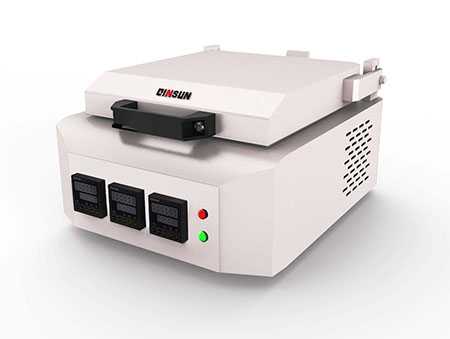Site: Home > News and events  QINSUN is committed to being partners with textile industry practitioners and textile enthusiasts to help them succeed, by providing technical knowledge and guidance on textile testing and textile laboratory equipment.
QINSUN is committed to being partners with textile industry practitioners and textile enthusiasts to help them succeed, by providing technical knowledge and guidance on textile testing and textile laboratory equipment.
What is the principle and certification standard of the sublimation color fastness tester?
The sublimation color fastness of printed and dyed textiles and the test of dye sublimation point are closely related to the temperature of the sample contacting the hot plate, the pressure exerted on the sample, the raw material of the lining cloth and the physical properties of the fabric structure. In order to make the test results reproducible and accurate, the sublimation fastness tester needs to be determined by the variable conditions in the test, such as pressure, temperature, interlining and other indicators.
What is the principle of sublimation fastness tester?
Scorch/Sublimation Tester is used in the laboratory to evaluate colour fastness to dry heat, hot pressing and sublimation, as well as thermal stability, can perform color fastness test of fabric, chlorine damaged test(resin finishing fabric), yellowing test of bleached fabric, sublimation fastness test for disperse dye, hot water fastness test for reactive dye.
The choice of pre-pressure:
In the sublimation fastness tester, the function of pressure is to ensure the uniform contact between the sample and the interlining, so that the interlining can be evenly stained and easy to judge the grade. The test found that when the pressure is less than 10 cN/cm2, the heated solid surface contacts the sample and the lining cloth unevenly, resulting in uneven staining number. When the pressure is between 20 and 80 cN/cm2, the influence on the stained sample and the degree of staining standard cluster did not cause any changes. For this reason, the LFY-6D textile dye sublimation color fastness tester selected a pressure of 4 k Pa.
The influence of textile fabric on sublimation color fastness test:
In the textile dye sublimation color fastness test, the raw materials and physical properties of the white interlining have an important relationship with the staining degree of the sample. Nylon, polyester, triacetate, viscose and pure cotton cloth dyed with disperse dyes were used as lining cloths. The more stained polyester fabrics were studied. During the heating process, some white interlinings are slightly discolored and stained, such as nylon fabrics that turn yellow after heating. The influence of the interlining on the sublimation color fastness test is also related to the physical properties of the interlining. Since the heating test time is only 30 seconds, the heat energy is transferred to the sample through the lining cloth, and the thickness and density of the lining cloth will affect the heat transfer to the sample. We tested different colors of acetate fabrics such as blue, purple and orange at 150℃, 180℃ and 210℃ for 30 seconds. The interlayer used pure cotton white interlining cloth (thickness about 0.14 mm) and triacetate fiber. (Thickness is about 0.028 mm), using three forms of superimposed one, two, and three layers of interlining cloth to test, the result is that only the interlining cloth in contact with the sample is stained, and the test of the three interlining cloths is slightly stained Reduced; the thickness of the interlining cloth in the range of 0.1 to 0.6 mm has little effect on the color fastness to sublimation.
What are the certification standards?
Traditionally, single-fiber standard lining fabrics are used to evaluate the staining performance of samples in textile color fastness tests. However, in recent years, the newly formulated international standards have gradually adopted multi-fiber lining as standard test materials.
The following are some of the testing and certification standards added to the selection of textile adhesives:
1. Color fastness to washing gb/t3921.1-gb/t3921.5
2. Color fastness to perspiration gb/t3922
3. Test method for color fastness to water gb/t5713
4. Test method for color fastness to sea water gb/t5714
5. Color fastness to dry heat (except hot pressing) gb/t5718
6. Test method for fastness to peroxide bleaching gb/t7070
7. Test method for color fastness to sodium chlorite to light bleaching gb/t7071
8. Test method for color fastness to sodium chlorite rebleaching gb/t7072
9. Test method for color fastness to organic solvents gb/t7074
10. Color fastness to alkali shrinkage gb/t8434
11. Test method for color fastness to sulfur fumigation gb/t8437
12. Color fastness to steam pleating gb/t8438
2021-08-06 13:25
- Related News
Automatic Cross-Hatch Tester | PV 3952, Ford BN 108-03,GM N 14688 Compliant
Multi-Finger Scratch/Mar Tester | Automotive Plastics & Interior Materials T
Dental Material Color Stability Tester | ISO 4049 / YY 0270 / ASTM G155 Complian
Masks Bacterial Filtration Efficiency (BFE) Tester | YY 0469 / ASTM F2100 / BS E
Smoke Density Tester | ASTM E662 / ISO 5659-2 Compliant
Dry Microbial Penetration Resistance Tester | ISO 22612 / YY/T 0506.5
Dry Fallen Wadding Tester — YY/T 0506.6 | ISO 9073-10 | EN 13795-2
Fogging Tester | Automotive Interior Volatile Fogging Test System

